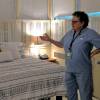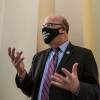Hospitals in the Greater Boston area are seeing an unusually early onslaught of respiratory syncytial virus, known as RSV. The slew of cases is filling up their emergency rooms, clogging up pediatric transfers and even causing some children to be sent across state lines for care.
With less exposure and immunity built up after more than two years of masking and social distancing, local providers say that many young children are likely being exposed to the virus for the first time and getting sick.
“Inpatient pediatric bed capacity is a huge issue right now in the metro Boston area, and actually even across the entire Northeast,” said Erin Beaumont of Cambridge Health Alliance. Pediatric patients with respiratory illnesses are filling up beds at the Cambridge Hospital Emergency Department and Somerville Campus Urgent Care, where she works as the site chief.
The two hospitals don’t have pediatric beds, but when children are very ill, they’re sent to other large area hospitals that have overnight pediatric beds — usually an easy process.
“[But] because their beds are all full, we're having to sometimes transfer kids across city lines, sometimes to other parts of the state,” Beaumont said. “Even in very extreme circumstances, we've had to transfer kids outside of the state, too. So it's definitely a huge issue that we're dealing with.”
More Local News
She said Cambridge Health Alliance and virtually every major hospital in the Greater Boston area has been meeting with the Department of Public Health to figure out who does and who doesn’t have pediatric beds, and pool resources. The agency didn’t return GBH News’ requests for comment.
Dr. Phoebe Yager, medical director of the Pediatric Intensive Care Unit at Mass General for Children, said the pandemic taught hospitals the importance of communication to get children the beds they need as fast as possible. Her own unit at Mass General is at capacity.
“We already have really good coordination across the PICUs in the state and the region, with weekly calls involving the DPH at the state level to do the best we can to get patients where they need to be to get the level of care that's most appropriate for them,” Yager said.
The virus is a major respiratory illness for young children. Providers in the area said a wave of RSV cases usually begins in November and tapers off through March. But this year, there have been many cases in the past couple of months, even in the summer, and major surges in the past two weeks.
“What we’re seeing in terms of RSV is definitely an increased number of cases of infection over the last several weeks,” said Dr. Kristin Moffitt of Boston Children’s Hospital. “But this was a very, very steep and fast rise in cases in earlier than we've seen it.”
The respiratory virus shows up as a mild cough, runny nose and cold-like symptoms, similar to COVID-19, according to the Mayo Clinic. It can be particularly dangerous in infants, small children and older adults.
Moffit said that, when her hospital tests pediatric patients with RSV symptoms, 20% have it.
People with asthma can also experience significant asthma attacks as a result of the infection, according to the Centers for Disease Control and Prevention. A severe RSV infection can cause pneumonia. There are 14,000 deaths annually in adults 65 and older due to RSV, and 100 to 300 in children, according to the Centers for Disease Control and Prevention.
Yager said there was practically no RSV season last year because of pandemic precautions like masking and social distancing.
“Suddenly we have kids going back to school, parents going back to work and they're now catching RSV and bringing it home to younger siblings and infants who really don't have much immunity,” she said. “It’s just the perfect storm to then create a situation of smaller children and infants getting really sick.”
Yager said children under 2 are typically exposed to RSV in daily life and have some immunity. With the COVID-19 pandemic, that changed.
“Right now, we're seeing really high cases and it’s only October,” Beaumont said. “It's hard to know if we're seeing a peak right now or if we're going to continue seeing things go up as the winter progresses.”









